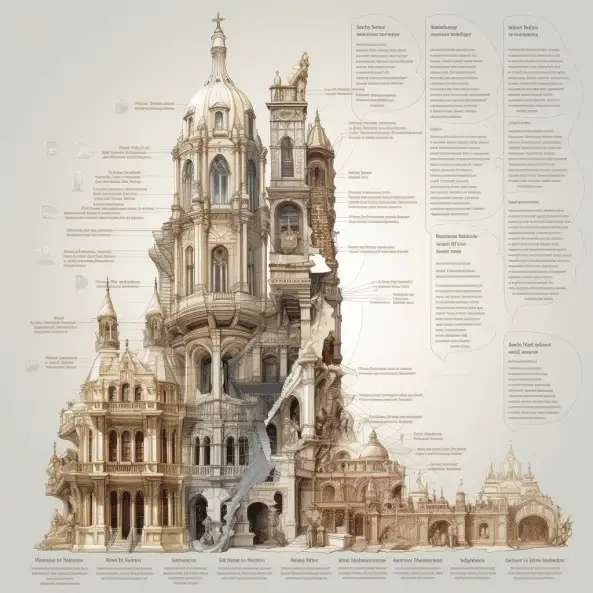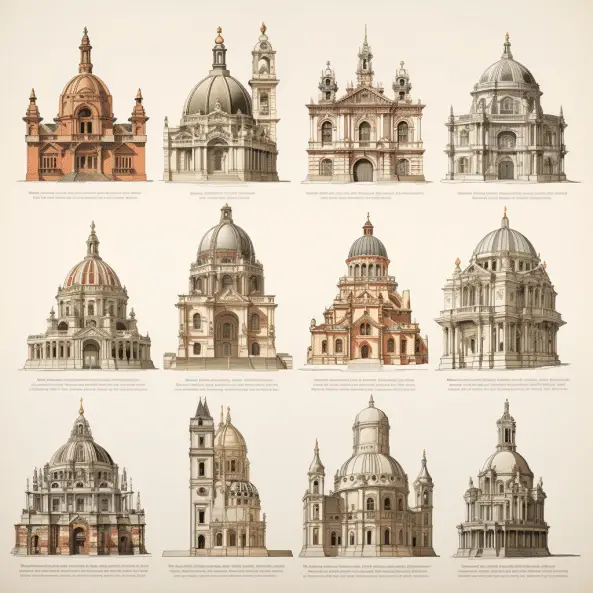Architectural History: Evolution of Styles and Structures
Architectural history is a fascinating journey that unveils the evolution of design trends and styles, shaping the built environment we inhabit today. From the Neolithic period to contemporary architecture, each era has left its mark, reflecting the cultural, technological, and social changes of its time.
Key Takeaways:
- Architecture dates back to the Neolithic period, around 10,000 BC.
- Early civilizations like the Egyptians and Sumerians developed unique architectural styles.
- The Greeks introduced the concept of public spaces and the classical orders.
- The Romans made significant contributions to architecture, including the use of arches and concrete.
- The Middle Ages focused on defense, resulting in the construction of castles and fortresses.
The Neolithic Period and Early Civilizations
The history of architecture can be traced back to the Neolithic period, around 10,000 BC, when humans began designing and constructing their own dwellings. During this time, communities transitioned from nomadic lifestyles to settled societies, leading to the development of permanent structures. In the Neolithic period, architecture was primarily focused on meeting basic needs such as shelter and protection.
The architectural practices of early civilizations played a crucial role in shaping the future of architecture. One notable example is ancient Egypt, where architecture became a symbol of power and spirituality. The Egyptians constructed monumental pyramids, such as the Great Pyramid of Giza, as tombs for their pharaohs. These structures showcased advanced engineering skills and a deep understanding of geometry.
Similarly, the Sumerians, an early civilization in Mesopotamia, made significant contributions to architectural design. They built towering ziggurats, which were stepped pyramids used as religious temples. These impressive structures reflected the Sumerians’ belief in the divine and served as focal points for their communities.
Both the Egyptian and Sumerian architectural styles laid the foundation for future architectural developments, influencing design principles and techniques that would be adopted by subsequent civilizations. The Neolithic period and early civilizations marked the beginning of a rich architectural history that continues to shape our built environment today.
| Neolithic Period and Early Civilizations: | Key Features |
|---|---|
| Egypt: | Monumental pyramids, advanced engineering, geometric precision |
| Sumeria: | Towering ziggurats, religious significance, community focal points |
Egyptian and Sumerian Architectural Styles
The Egyptians and Sumerians made significant contributions to architectural history, with their distinct styles and iconic structures that continue to captivate us today. Egyptian architecture, characterized by grandeur and monumentality, is best known for its awe-inspiring pyramids. These massive structures, built as tombs for pharaohs, were constructed with precise mathematical calculations and engineering prowess. The most famous of these pyramids is the Great Pyramid of Giza, one of the Seven Wonders of the Ancient World.
On the other hand, the Sumerians, an ancient civilization in Mesopotamia, developed unique architectural designs centered around their religious beliefs. Their most notable architectural marvels are the ziggurats, towering stepped structures that served as religious temples. The best-preserved example is the Great Ziggurat of Ur, which showcases the Sumerian’s advanced knowledge of construction and engineering.
Both the Egyptians and Sumerians utilized intricate decorative elements and employed architectural techniques that were ahead of their time. The Egyptians focused on symmetry and harmony, using massive stone blocks to create enduring structures. In contrast, the Sumerians embraced the use of mudbrick and employed arches and vaults, demonstrating their architectural ingenuity.
| Egyptian Architecture | Sumerian Architecture |
|---|---|
| Awe-inspiring pyramids | Towering ziggurats |
| Precise mathematical calculations | Advanced engineering |
| Focus on symmetry and harmony | Use of arches and vaults |
The architectural styles of the Egyptians and Sumerians have left a lasting impact on the field of architecture. Their innovative designs, technical achievements, and cultural significance continue to inspire architects and designers around the world. By studying these ancient civilizations, we gain a deeper understanding of the origins of architecture and the enduring power of human creativity.

Greek Influence on Western Architecture
The Greeks revolutionized architecture by introducing the concept of public spaces and establishing the principles of the classical orders, which have strongly influenced Western design. Greek architecture is characterized by a sense of harmony, balance, and proportion, seeking to create spaces that are not only functional but also aesthetically pleasing.
The use of public spaces, such as temples, theaters, and agora, became an integral part of Greek city planning. These spaces were not just utilitarian but also served as gathering places for social, political, and cultural activities. The design of these public spaces allowed for social interaction, fostering a sense of community and civic pride.
The Greeks also developed the classical orders, which are a system of architectural elements and proportions used in the design of temples and public buildings. The three main orders are the Doric, Ionic, and Corinthian, each with its distinct characteristics and decorative features. These orders provided a framework for architectural aesthetics and played a vital role in the development of Western architecture.
The influence of Greek architecture can be seen in various Western architectural styles throughout history. From the Roman period to the Renaissance and beyond, the principles of Greek design have continued to shape the way we conceive and construct buildings. The legacy of Greek architecture is evident in the columns, pediments, and symmetry that are still prevalent in many structures today.
| Key Features of Greek Architecture |
|---|
| Use of public spaces |
| Classical orders: Doric, Ionic, Corinthian |
| Harmony, balance, and proportion |
| Sense of community and civic pride |
| Influence on Western architecture |
“Greek architecture has left an indelible mark on the history of art and design. The principles of public spaces and classical orders introduced by the Greeks have shaped the way we think about and create architecture. It is a testament to the lasting impact of their innovative ideas and timeless aesthetics.”
Summary:
- Greek architecture revolutionized the field by introducing public spaces and the classical orders.
- Public spaces, such as temples and agora, served as gathering places for social and cultural activities.
- The classical orders, including Doric, Ionic, and Corinthian, established a framework for architectural aesthetics.
- The influence of Greek design can be seen in various Western architectural styles throughout history.
Roman Architectural Innovations
With their use of arches and concrete to build vast monuments, the Romans revolutionized architecture. The Romans used semicircular or pointed arches supported by columns or piers to span enormous distances and create spacious rooms. The solidity and flexibility of this architectural invention allowed monumental structures to be conceived and built.
Concrete, another Roman invention, was vital to their architecture. The Romans made a durable and flexible building material from lime, volcanic ash, and crushed stone or brick. Concrete enabled elaborate building patterns and shapes, expanding architectural expression. One of the most iconic Roman buildings, the Pantheon, uses arches and concrete to demonstrate ancient Roman architects’ inventiveness and engineering.
The Romans also used architectural aspects to improve their buildings’ appearance and functionality. They created stunning façades and majestic entryways with colonnades. The addition of domes, vaults, and coffered ceilings gave Roman architecture a refined look. These architectural innovations inspired generations of architects and shaped future styles.
Table: Famous Roman Architectural Structures
| Structure | Location | Architectural Features |
|---|---|---|
| Colosseum | Rome, Italy | Arches, concrete, amphitheater design |
| Pantheon | Rome, Italy | Dome, oculus, coffered ceiling |
| Aqueducts | Varies across the Roman Empire | Arches, concrete, water transportation |
| Baths of Caracalla | Rome, Italy | Concrete, hypocaust system, mosaics |
The architectural achievements of the Romans have had a lasting impact on the field of architecture. Their innovative use of arches, concrete, and various design elements have shaped the built environment for centuries. It is a testament to their ingenuity and engineering prowess that many of their structures still stand today, inspiring awe and admiration. Roman architecture continues to be studied and appreciated, serving as a foundation for architectural knowledge and inspiring contemporary designers to push the boundaries of creativity.
Medieval Defense Architecture
Defense-focused architecture led to the construction of powerful castles and fortresses across Europe in the medieval period. In this era of incessant warfare and the need for safety, architects designed buildings that could withstand attacks and safeguard their residents.
Medieval military architecture was characterized by strategic positioning. Castles were typically erected on hills or cliff edges for observation points and difficulty of access. This advantage allowed castle residents to watch for oncoming foes and plan accordingly.
Castles and fortresses had substantial stone or brick walls to withstand siege attacks in addition to their commanding locations. Attackers were frightened by these walls’ physical and psychological barriers. Many castles had moats, drawbridges, and reinforced entrances to strengthen their defenses. These characteristics were meant to slow the attacker and give defenders time to prepare and counterattack.
The Evolution of Medieval Defense Architecture
- Early medieval castles were relatively simple, consisting of a central tower, known as a keep, surrounded by a wooden palisade. Over time, these basic structures evolved into complex fortresses with multiple defensive layers, such as curtain walls, towers, and bastions.
- The introduction of new defensive technologies, such as trebuchets and battering rams, led to the development of defensive architectural innovations. These included the incorporation of arrow slits, murder holes, and battlements, which allowed defenders to shoot at attackers while remaining protected.
- As siege warfare became more sophisticated, architects responded with advancements in castle design. Concentric castles, which featured multiple rings of defensive walls and towers, became prevalent during the later medieval period. These concentric designs were incredibly challenging for attackers to breach, as each layer had to be captured before reaching the innermost keep.
Medieval defense architecture represents a crucial period in architectural history. The castles and fortresses constructed during this era not only served as symbols of power and authority but also reflected the societal concerns and constant state of warfare prevalent at the time. Today, these architectural marvels stand as a testament to the ingenuity and craftsmanship of the medieval architects who built them.
| Castle | Location | Features |
|---|---|---|
| Windsor Castle | England | Tower Keep, Curtain Walls, Round Towers |
| Château de Chillon | Switzerland | Waterfront Location, Fortified Walls, Courtyard |
| Conwy Castle | Wales | Massive Curtain Walls, Multiple Towers, Great Hall |
The Renaissance and Rebirth of Architecture
Perspective and classical aspects reshaped architecture during the Renaissance. From the 14th to the 17th century, old Greek and Roman architecture was revived, resulting in stunning buildings that still astonish.
Renaissance architects and painters developed new methods to create more realistic and dynamic structures. Perspective was crucial to architectural design since structures were now built to look three-dimensional on a two-dimensional surface.
The grandeur of old Roman and Greek buildings encouraged the revival of classical components like columns, pediments, and domes. Renaissance aesthetics valued balance and proportion, and these traits gave the constructions a sense of elegance and harmony.
The Influence of Perspective in Renaissance Architecture
Perspective, a technique that creates the illusion of depth and space, allowed architects to design structures that appeared more realistic and visually striking. Buildings were no longer flat and two-dimensional but rather came to life, with facades that seemed to recede into the distance. This new approach to architecture was made possible through the study of mathematics and the principles of linear perspective.
| Key Characteristics of Renaissance Architecture |
|---|
| Use of perspective to create a sense of depth and realism |
| Incorporation of classical elements such as columns, pediments, and domes |
| Emphasis on balance, proportion, and harmony |
| Integration of art and architecture |
One of the most iconic examples of Renaissance architecture is the dome of the Florence Cathedral, designed by Filippo Brunelleschi. This groundbreaking structure showcased the mastery of perspective, with its grand dome appearing to stretch infinitely towards the sky. The dome became a symbol of the Renaissance’s innovative approach to architecture, as well as a testament to human ingenuity and creative vision.
The Renaissance marked a significant turning point in architectural history, influencing future generations of architects and shaping the way we perceive and design buildings. The emphasis on perspective and the revival of classical elements continue to be celebrated in contemporary architecture, showcasing the enduring legacy of this transformative period.
Byzantine and Gothic Styles
Medieval Byzantine and Gothic architecture introduced distinct design characteristics and shaped architectural history. Domes, mosaics, and exquisite embellishment characterize Byzantine architecture, influenced by Eastern Roman Empire. The Hagia Sophia, with its huge dome and gold mosaic interior, is a marvel of Byzantine architecture. This design highlighted religious buildings’ grandeur and spirituality.
Gothic architecture developed in Western Europe in response to Romanesque architecture. High vaulted ceilings, pointed arches, and flying buttresses define it. Gothic churches, like Notre-Dame in Paris, highlighted technological advances that allowed taller and larger interiors. These majestic monuments had an ethereal beauty from stained glass windows, elaborate stone carvings, and ribbed vaults.
Key Characteristics of Byzantine and Gothic Architecture:
- Byzantine architecture: domes, mosaics, intricate decoration, grandeur
- Gothic architecture: pointed arches, flying buttresses, ribbed vaults, stained glass windows
Both styles reflected the societal and cultural values of their time. Byzantine architecture conveyed the power and influence of the Eastern Roman Empire, while Gothic architecture represented the growing wealth and influence of the Church. Today, these architectural styles continue to inspire and captivate us, reminding us of the rich history and artistic achievements of the medieval period.
| Byzantine Architecture | Gothic Architecture |
|---|---|
| Characterized by domes and mosaics | Characterized by pointed arches and flying buttresses |
| Emphasized grandeur and spirituality | Showcased technological advancements |
| Used intricate decoration | Incorporated stained glass windows and ribbed vaults |
“Byzantine and Gothic architecture are not just architectural styles, but reflections of the values and aspirations of their respective civilizations.” – Architectural historian
Architecture Reflecting Societal Changes
Architecture has always reflected social changes and cultural beliefs, adapting to the needs of diverse populations. From Neolithic huts to Renaissance castles, every architectural style conveys a tale of people and their goals.
Ancient Egyptian and Sumerian architecture expressed authority and religion. The Sumerian ziggurats symbolized heaven and earth, whereas Egypt’s pyramids symbolized the pharaoh’s divinity from their size and complexity.
The Middle Ages saw a shift towards defensive architecture, with the construction of fortified castles and fortresses. These structures were not only physical barriers against invasions but also symbols of status and authority. The grandeur of medieval architecture displayed the feudal system and the power of the ruling elite.
| Architectural Style | Period | Key Characteristics |
|---|---|---|
| Greek | 5th – 4th century BCE | Classical orders, harmony, proportion |
| Roman | 1st century BCE – 4th century CE | Arches, concrete, grandeur |
| Gothic | 12th – 16th century CE | Pointed arches, ribbed vaults, stained glass |
The Renaissance marked a rebirth of architectural ideas and a renewed focus on humanism and perspective. Artists and architects like Brunelleschi and Alberti revolutionized the field by rediscovering the principles of ancient Rome and Greece. The result was a harmonious blend of classical elements and innovative design, shaping the future of architecture.
Architecture Reflecting Societal Changes
Throughout history, architecture has been a reflection of the values and beliefs of society. It has adapted to societal changes, whether political, religious, or cultural, and has served as a tangible representation of these shifts. From the towering pyramids to the soaring Gothic cathedrals, each architectural style tells a story of the people and their aspirations.
“Architecture should speak of its time and place, but yearn for timelessness.” – Frank Gehry
In the ancient world, architecture often served as a display of power and religious devotion. The pyramids of Egypt, with their grand scale and precise construction, were a testament to the pharaoh’s authority and their belief in an afterlife. Meanwhile, the intricate temples and ziggurats of Mesopotamia showcased the Sumerians’ reverence for their gods and their desire to reach the heavens.
As societies evolved, so did architectural styles. The Greeks, with their emphasis on democracy and civic life, built temples and theaters that celebrated communal gathering. The Romans, known for their engineering prowess, constructed monumental structures such as aqueducts and amphitheaters, showcasing their mastery of technology and their desire for grandeur.
The Middle Ages witnessed a shift in architectural focus towards defense and spiritualism. Medieval castles and fortresses were constructed to protect against invasions, reflecting the turbulent times in which they were built. Gothic cathedrals rose towards the heavens, with their soaring arches and stained glass windows, expressing the aspiration for spiritual transcendence.
Table: Architectural Styles and Periods
| Architectural Style | Period | Key Characteristics |
|---|---|---|
| Neolithic Period | 10,000 – 2,000 BC | Simple, functional structures |
| Ancient Egypt | 3,100 – 30 BC | Pyramids, temples, obelisks |
| Greek | 800 – 200 BC | Classical orders, civic spaces |
| Roman | 500 BC – 500 AD | Arches, concrete, monumental structures |
| Gothic | 12th – 16th century | Pointed arches, ribbed vaults, stained glass |
Architecture continues to evolve, reflecting the values and needs of modern society. Sustainable design and eco-friendly construction practices have emerged as a response to environmental concerns, showing a growing awareness of our impact on the planet. The use of technology and innovative materials has opened up new possibilities in design, allowing architects to create structures that were once unimaginable.
As we move forward, architecture will continue to be shaped by societal changes and cultural values. It will serve as a canvas for expression, a reflection of our collective aspirations, and a testament to our ever-evolving world.
The Influence of Sustainability on Modern Architecture
Sustainable design has been a priority in modern architecture to address global issues. To reduce environmental effect and improve living conditions, architects and designers are incorporating sustainable methods into their designs.
Modern sustainable building emphasizes energy efficiency. Designing buildings to utilize natural lighting and ventilation reduces the need for artificial lighting and air conditioning. Energy-efficient technology like solar panels and geothermal heating allow buildings to generate clean energy and reduce fossil fuel use.
Construction materials are crucial to sustainable building. Architects are using recycled steel, sustainable timber, and low-emission concrete to reduce carbon emissions. Green roofs and vertical gardens are popular for their aesthetics, carbon dioxide absorption, air purification, and insulation.
Sustainable architecture goes beyond individual buildings. Urban planning and community design are key to sustainable cities. By adding green areas, pedestrian-friendly surroundings, and efficient transit networks, architects and urban planners reduce pollution, promote physical and mental health, and build community.
| Benefits of Sustainable Architecture |
|---|
| 1. Reduced energy consumption and carbon footprint |
| 2. Healthier and more comfortable living spaces |
| 3. Conservation of natural resources |
| 4. Improved air and water quality |
| 5. Enhanced resilience to climate change |
In conclusion, sustainability has become a driving force in modern architecture, revolutionizing design practices and shaping the future of our built environment. By prioritizing eco-friendly design principles, architects are not only creating visually stunning structures but also contributing to a healthier and more sustainable planet for future generations.
Contemporary Architecture and Future Trends
Due to technical advances and changing social needs, contemporary architecture incorporates many new design methods and sets the stage for future trends. Today’s architects use innovative materials, ecological practices, and innovative construction methods to produce beautiful, eco-friendly buildings.
Green design is essential in modern architecture due to the requirement for sustainability. Buildings use energy-efficient systems, renewable energy, and smart technologies to reduce energy use and carbon emissions. To encourage biodiversity and improve city life, architects are adding living walls, rooftop gardens, and vertical farms.
Digital innovation is also the future of architecture. With parametric design, architects use powerful software and algorithms to create complicated forms and improve structural performance. 3D printing allows precise and fast manufacturing of sophisticated building components, changing the construction industry. VR and AR are enabling immersive design presentations and interactive client interaction in architecture.
Architecture will adapt to meet society’s needs and aspirations. Sustainable practices, digital technologies, and social considerations will define future design, generating beautiful, responsive, adaptive, and inclusive built environments.
| Trends in Contemporary Architecture | Description |
|---|---|
| Sustainable Design | Integration of eco-friendly practices and materials to reduce environmental impact. |
| Digital Innovation | Utilization of advanced software, 3D printing, and virtual reality in architectural processes. |
| Biophilic Design | Incorporation of nature into urban environments to improve human well-being. |
| Adaptive Reuse | Repurposing existing structures for new functions, promoting sustainability and cultural preservation. |

Conclusion
The history of architecture is a fascinating look at how design has evolved to meet our need for useful and beautiful buildings. From the Neolithic period, when mankind built their own buildings, to ancient Egypt’s grandeur and Sumerians’ unique styles, architectural history is rich.
Greeks invented public places and classical orders, which shaped Western architecture. Roman engineers invented concrete and arches. The Middle Ages saw the development of massive castles and fortifications for defense. Renaissance art broke new ground with perspective and classical components.
Byzantine and Gothic styles also arose, each with their own influences. For centuries, architecture has reflected social changes and cultural beliefs, responding to community requirements. Sustainable designs and materials are being used by architects. Contemporary architecture promises new design ideas and cutting-edge technology.
In conclusion, the history of architecture contains design trends and styles as well as human intellect and invention. It reminds us to seek constructions that are both functional and beautiful.
FAQ
Q: What is the history of architecture?
A: The history of architecture dates back to the Neolithic period, around 10,000 BC, when people started designing and constructing their own houses. Architecture has always been closely intertwined with the history of art, as buildings often served aesthetic and functional purposes. Throughout history, architecture has reflected societal changes and cultural values.
Q: What were some early architectural styles?
A: Early civilizations like the Egyptians and Sumerians developed unique architectural styles. Egypt is known for constructing pyramids, while the Sumerians built ziggurats. These architectural styles showcased the craftsmanship and grandeur of these ancient civilizations.
Q: How did Greek architecture influence Western architecture?
A: The Greeks introduced the concept of public spaces and developed the classical orders, which greatly influenced Western architecture. The use of proportion, harmony, and symmetry in Greek architecture continues to be admired and emulated today.
Q: What architectural contributions did the Romans make?
A: The Romans made significant contributions to architecture, including the use of arches and the invention of concrete. Their architectural innovations enabled the construction of massive structures, such as aqueducts and amphitheaters.
Q: How did architecture evolve during the Middle Ages?
A: In the Middle Ages, architectural developments were focused on defense, resulting in the construction of castles and fortresses. The need for protection influenced the design and layout of these medieval structures.
Q: What characterized the Renaissance period in architecture?
A: The Renaissance marked a breaking point in architectural history, with a renewed focus on perspective and the use of classical elements. Architects during this period sought to recreate the harmony and balance of ancient Roman and Greek architecture.
Q: What are the characteristics of Byzantine and Gothic architecture?
A: Byzantine architecture is known for its ornate decorations, domes, and mosaics, while Gothic architecture is characterized by pointed arches, ribbed vaults, and large stained glass windows. Both styles were prominent during the medieval period.
Q: How does architecture reflect societal changes and cultural values?
A: Architecture has always been a reflection of societal changes and cultural values. Different architectural styles and designs emerge in response to shifts in politics, religion, technology, and social norms.
Q: How is sustainability influencing modern architecture?
A: Sustainability has become a significant influence on modern architecture. Architects are incorporating eco-friendly design principles, using renewable materials, and focusing on energy efficiency to create buildings that have a minimal environmental impact.
Q: What are some current trends in contemporary architecture?
A: Contemporary architecture is characterized by innovative designs and the use of advanced technologies. Trends include the integration of nature into buildings, sustainable urban planning, and the utilization of smart materials that adapt to changing needs.







